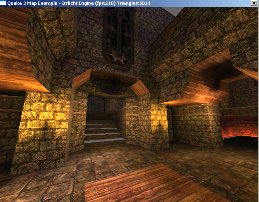
This tutorial shows how to load a Quake 3 map into the engine, create a SceneNode for optimizing the speed of rendering, and how to create a user controlled camera.
Please note that you should know the basics of the engine before starting this tutorial. Just take a short look at the first tutorial, if you haven't done this yet: http://irrlicht.sourceforge.net/docu/example001.html
Lets start like the HelloWorld example: We include the irrlicht header files and an additional file to be able to ask the user for a driver type using the console.
As already written in the HelloWorld example, in the Irrlicht Engine everything can be found in the namespace 'irr'. To get rid of the irr:: in front of the name of every class, we tell the compiler that we use that namespace from now on, and we will not have to write that 'irr::'. There are 5 other sub namespaces 'core', 'scene', 'video', 'io' and 'gui'. Unlike in the HelloWorld example, we do not call 'using namespace' for these 5 other namespaces, because in this way you will see what can be found in which namespace. But if you like, you can also include the namespaces like in the previous example.
Again, to be able to use the Irrlicht.DLL file, we need to link with the Irrlicht.lib. We could set this option in the project settings, but to make it easy, we use a pragma comment lib:
OK, lets start. Again, we use the main() method as start, not the WinMain().
Like in the HelloWorld example, we create an IrrlichtDevice with createDevice(). The difference now is that we ask the user to select which video driver to use. The Software device might be too slow to draw a huge Quake 3 map, but just for the fun of it, we make this decision possible, too.
Get a pointer to the video driver and the SceneManager so that we do not always have to call irr::IrrlichtDevice::getVideoDriver() and irr::IrrlichtDevice::getSceneManager().
To display the Quake 3 map, we first need to load it. Quake 3 maps are packed into .pk3 files which are nothing else than .zip files. So we add the .pk3 file to our irr::io::IFileSystem. After it was added, we can read from the files in that archive as if they were stored on disk.
Now we can load the mesh by calling irr::scene::ISceneManager::getMesh(). We get a pointer returned to an irr::scene::IAnimatedMesh. Quake 3 maps are not really animated, they are only a chunk of static geometry with some materials attached. Hence the IAnimatedMesh consists of only one frame, so we get the "first frame" of the "animation", which is our quake level and create an Octree scene node with it, using irr::scene::ISceneManager::addOctreeSceneNode(). The Octree optimizes the scene a little bit, trying to draw only geometry which is currently visible. An alternative to the Octree would be a irr::scene::IMeshSceneNode, which would always draw the complete geometry of the mesh, without optimization. Try it: Use irr::scene::ISceneManager::addMeshSceneNode() instead of addOctreeSceneNode() and compare the primitives drawn by the video driver. (There is a irr::video::IVideoDriver::getPrimitiveCountDrawn() method in the irr::video::IVideoDriver class). Note that this optimization with the Octree is only useful when drawing huge meshes consisting of lots of geometry and if users can't see the whole scene at once.
Because the level was not modeled around the origin (0,0,0), we translate the whole level a little bit. This is done on irr::scene::ISceneNode level using the methods irr::scene::ISceneNode::setPosition() (in this case), irr::scene::ISceneNode::setRotation(), and irr::scene::ISceneNode::setScale().
Now we need a camera to look at the Quake 3 map. We want to create a user controlled camera. There are some cameras available in the Irrlicht engine. For example the MayaCamera which can be controlled like the camera in Maya: Rotate with left mouse button pressed, Zoom with both buttons pressed, translate with right mouse button pressed. This could be created with irr::scene::ISceneManager::addCameraSceneNodeMaya(). But for this example, we want to create a camera which behaves like the ones in first person shooter games (FPS) and hence use irr::scene::ISceneManager::addCameraSceneNodeFPS().
The mouse cursor needs not be visible, so we hide it via the irr::IrrlichtDevice::ICursorControl.
Everything is set up, so lets draw it. We also write the current frames per second and the primitives drawn into the caption of the window. The test for irr::IrrlichtDevice::isWindowActive() is optional, but prevents the engine to grab the mouse cursor after task switching when other programs are active. The call to irr::IrrlichtDevice::yield() will avoid the busy loop to eat up all CPU cycles when the window is not active.
In the end, delete the Irrlicht device.
That's it. Compile and play around with the program.